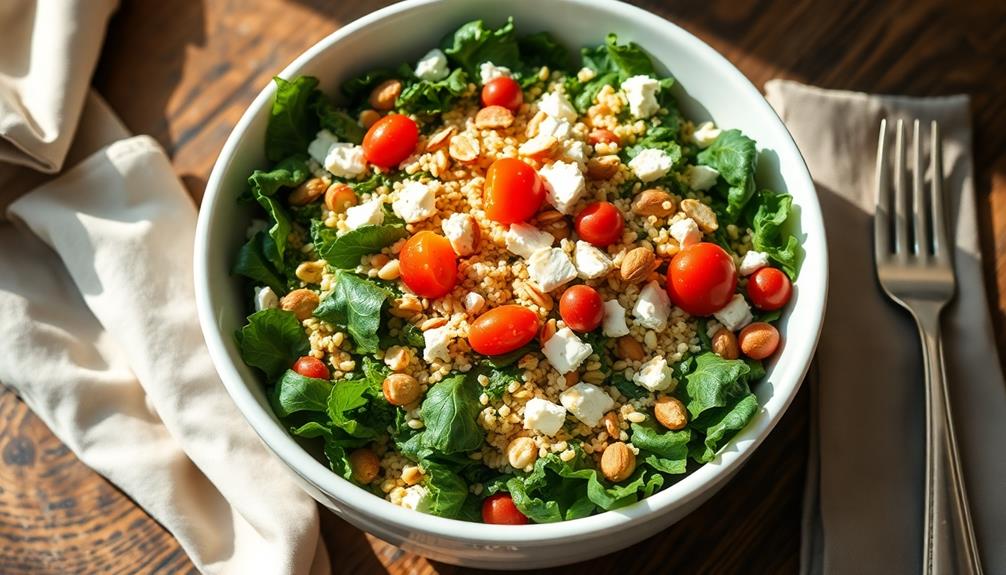Kale and quinoa salad is a nutrient-packed dish that's gained popularity in recent years. You'll love how it combines ancient ingredients in a modern, healthy meal. To make it, cook quinoa and chop fresh kale. Mix them with a tangy lemon vinaigrette, dried cranberries, and toasted nuts for added flavor and crunch. This versatile salad is perfect for meal prep and can be customized with your favorite toppings. It's rich in protein, fiber, and antioxidants, making it great for your overall health. Whether you're a health enthusiast or just looking for a tasty meal, there's so much more to discover about this nutritious combo.
Key Takeaways
- Kale and quinoa salad combines two nutrient-dense superfoods rich in vitamins, minerals, and antioxidants.
- The salad typically includes a lemon vinaigrette, dried cranberries, nuts, and feta cheese for flavor and texture.
- Preparation involves cooking quinoa, chopping kale, and mixing ingredients with a homemade dressing.
- The dish is customizable with various add-ins like grilled chicken, chickpeas, or seasonal fruits and vegetables.
- It's ideal for meal prep, keeps well for days, and can be served warm or cold.
History
Tracing the roots of kale and quinoa salad reveals a modern fusion of ancient ingredients.
You'll find that kale has been cultivated for over 2,000 years, originating in the eastern Mediterranean. It's been a staple in European cuisine for centuries, especially in colder regions where it thrives.
Quinoa, on the other hand, comes from South America. The Incas called it the "mother of all grains" and have grown it for about 5,000 years in the Andean regions.
The combination of kale and quinoa in a salad is a relatively recent trend. It gained popularity in the early 2010s as part of the health food movement.
You've probably noticed it popping up in trendy cafes and health-focused restaurants. This salad brings together the nutritional powerhouses of two different continents, creating a dish that's both healthy and delicious.
The pairing reflects our modern global food culture, where ingredients from different parts of the world can easily come together on your plate. It's a perfect example of how ancient foods can be reimagined for today's health-conscious eaters.
Recipe
This vibrant Kale and Quinoa Salad is a nutritious powerhouse that combines the earthy flavor of kale with the protein-packed goodness of quinoa. Proper nutrition is essential for cognitive development and emotional well-being, making this salad an excellent choice for both children and adults nutrition's role in development.
Perfect for a light lunch or as a side dish, this salad is both satisfying and refreshing. The beauty of this recipe lies in its versatility. You can easily customize it with your favorite toppings or seasonal ingredients, making it a go-to dish for any time of the year. The lemon vinaigrette adds a bright, zesty flavor that complements the hearty kale and quinoa perfectly.
- 1 cup quinoa
- 2 cups water
- 1 bunch kale, stems removed and leaves chopped
- 1/4 cup olive oil
- 2 tablespoons lemon juice
- 1 clove garlic, minced
- 1/4 cup dried cranberries
- 1/4 cup sliced almonds
- 1/4 cup crumbled feta cheese
- Salt and pepper to taste
Rinse the quinoa and cook it in water according to package instructions. While the quinoa is cooking, prepare the kale by massaging it with a tablespoon of olive oil to soften the leaves.
In a small bowl, whisk together the remaining olive oil, lemon juice, and minced garlic to make the dressing. Once the quinoa has cooled slightly, combine it with the kale in a large bowl. Add the dried cranberries, sliced almonds, and feta cheese. Pour the dressing over the salad and toss to combine. Season with salt and pepper to taste.
For best results, allow the salad to sit for at least 30 minutes before serving to let the flavors meld together. This salad can be served warm or cold, and it keeps well in the refrigerator for up to three days.
To add more protein, consider including grilled chicken or chickpeas. You can also experiment with different nuts or seeds, such as pumpkin seeds or walnuts, to vary the texture and flavor profile of the dish.
Cooking Steps
You'll start by rinsing and drying the kale, then cooking the quinoa until it's fluffy.
Next, you'll prepare a zesty lemon vinaigrette dressing to bring the flavors together.
Step 1. Rinse and Dry Kale
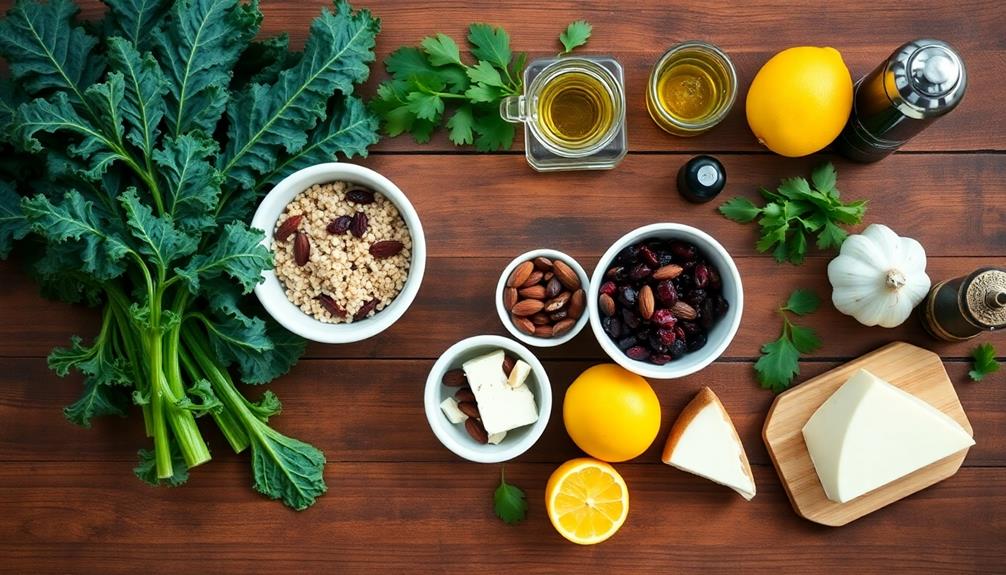
Before preparing your kale, it's essential to give it a thorough rinse. Start by filling a large bowl with cool water and submerge the kale leaves. Gently swish them around to remove any dirt or debris. You'll want to do this a few times, changing the water until it runs clear. This step ensures your kale is clean and free from any gritty texture.
Once you've rinsed the kale, it's time to dry it. Shake off excess water and lay the leaves on a clean kitchen towel or paper towels. Pat them gently to remove most of the moisture. If you have a salad spinner, it's a great tool to use here. Just place the kale in the spinner and give it a whirl. The centrifugal force will quickly remove most of the water, leaving your kale crisp and ready to use.
Properly drying your kale is crucial because it helps the dressing stick better and prevents your salad from becoming watery. It also makes the kale easier to chop and handle in the next steps of your recipe.
Step 2. Cook Quinoa Until Fluffy
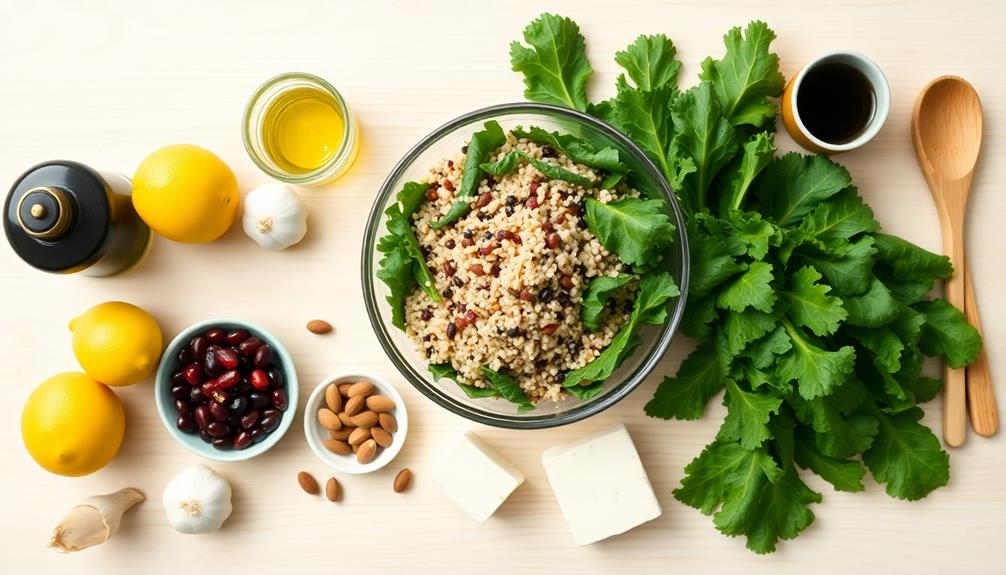
Cooking quinoa to fluffy perfection is a crucial step in creating a delicious kale and quinoa salad. To start, rinse your quinoa in a fine-mesh strainer under cold water. This removes any bitter coating and ensures a clean taste.
Next, combine one part quinoa with two parts water in a saucepan. For example, use 1 cup of quinoa and 2 cups of water.
Bring the mixture to a boil over high heat, then reduce the heat to low and cover the pan. Let it simmer for about 15 minutes, or until the water is absorbed. You'll know it's done when the quinoa grains have small spirals that have separated from the seeds.
Once the water is gone, remove the pan from heat and let it sit, covered, for 5 minutes. This resting period allows the quinoa to absorb any remaining moisture and become light and fluffy.
Step 3. Prepare Lemon Vinaigrette Dressing
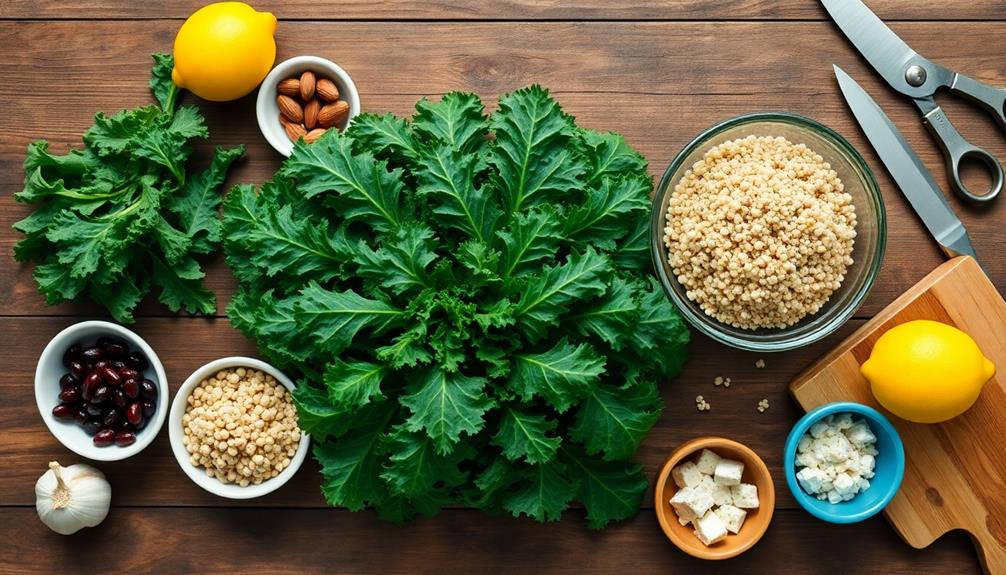
While the quinoa cools, it's time to whip up a zesty lemon vinaigrette dressing. You'll need fresh lemon juice, extra virgin olive oil, Dijon mustard, honey, and a pinch of salt and pepper.
In a small bowl, squeeze the juice of two lemons. Add three tablespoons of olive oil, one teaspoon of Dijon mustard, and one teaspoon of honey. Whisk these ingredients together until they're well combined. Incorporating fresh lemon juice can also uplift your mood, as citrus scents are linked to increased feelings of happiness.
Next, add a quarter teaspoon of salt and a few grinds of black pepper. Taste the dressing and adjust the flavors to your liking. If it's too tart, add a bit more honey. If it needs more zing, squeeze in some extra lemon juice. The key is to find a balance that suits your taste buds.
Once you're happy with the flavor, give the dressing one final whisk. It should look smooth and slightly thickened.
If you're not using the dressing right away, cover the bowl with plastic wrap and store it in the fridge. Just remember to give it a good shake or stir before you use it, as the ingredients may separate while chilling.
Step 4. Toss Ingredients Together
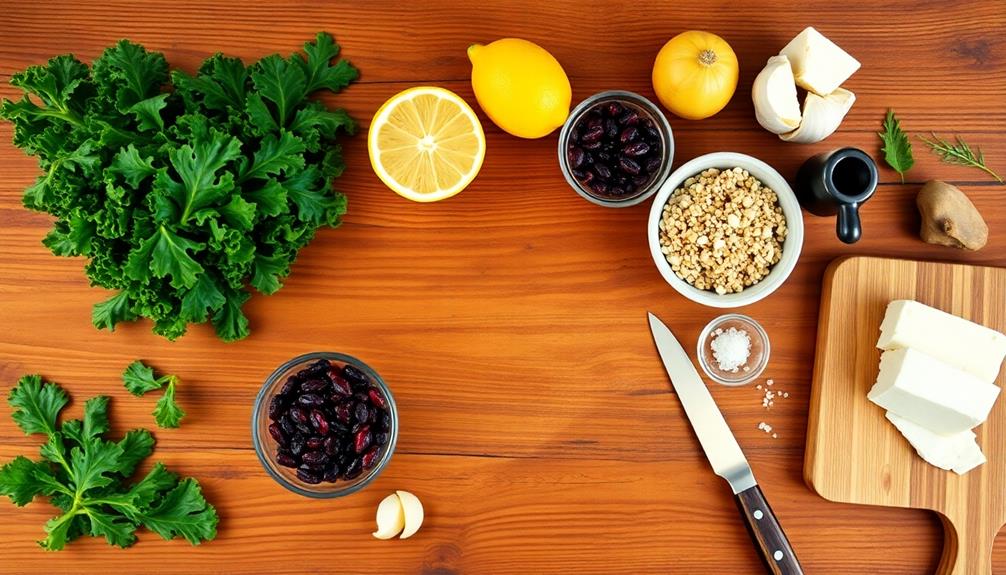
The salad's assembly begins with a large mixing bowl. You'll want to add your washed and chopped kale first. Give it a gentle massage with your hands to soften it up a bit. This helps make the kale more tender and easier to eat.
Next, add your cooked and cooled quinoa to the bowl. It's important that the quinoa isn't hot, or it'll wilt the kale.
Then, toss in your sliced almonds, dried cranberries, and any other add-ins you've chosen. These extras will give your salad a nice crunch and a burst of flavor.
Now, it's time for the dressing. Pour your prepared lemon vinaigrette over the salad ingredients. Start with about half of what you've made, as you can always add more later.
Using two large spoons or salad tongs, gently toss everything together. Make sure the dressing coats all the ingredients evenly. Take your time with this step to ensure every bite is flavorful.
Once everything's well mixed, give your salad a taste. If you think it needs more dressing or seasoning, go ahead and add it now.
Then give it one final toss before serving.
Step 5. Add Toasted Pumpkin Seeds

To elevate your kale and quinoa salad, toasted pumpkin seeds make an excellent addition. They're not only a delightful crunch but also provide essential nutrients, similar to how oatmeal aids digestion for dogs.
Start by spreading a handful of raw pumpkin seeds on a baking sheet. Place them in a preheated oven at 350°F (175°C) for about 5-7 minutes. Keep a close eye on them, as they can burn quickly. You'll know they're ready when they turn golden brown and smell fragrant.
Once toasted, let the seeds cool for a few minutes. Then, sprinkle them generously over your prepared kale and quinoa salad. You can add them just before serving to maintain their crispness. If you'd like, you can also mix some into the salad to distribute the flavor throughout.
For extra taste, try seasoning the seeds with a pinch of salt or your favorite spices before toasting. This simple step will transform your salad, adding texture and a nutty flavor that complements the earthy kale and protein-rich quinoa perfectly.
Don't be afraid to experiment with the amount – more seeds mean more crunch!
Final Thoughts
Kale-quinoa combos have become a health-food staple for good reason. They're packed with nutrients and offer a satisfying blend of textures.
As you've seen, creating your own kale and quinoa salad is easy and fun. You can mix and match ingredients to suit your taste or what's in your fridge.
Remember, the key to a great salad is balance. You want a mix of flavors and textures that complement each other. Don't be afraid to experiment with different dressings or toppings. If you're not a fan of pumpkin seeds, try almonds or walnuts instead. You can also add fruit like dried cranberries or fresh apple slices for a touch of sweetness. To add a pop of color and freshness to your salad, consider adding heirloom tomatoes. Their vibrant hues and unique textures will elevate your salad to the next level. If you’re looking for inspiration, try searching for an heirloom tomato salad recipe online for some new ideas and flavor combinations.
This salad is perfect for meal prep. You can make a big batch and enjoy it throughout the week. Just keep the dressing separate until you're ready to eat.
It's a great option for lunch at work or a quick dinner. With its mix of protein, fiber, and healthy fats, this salad will keep you feeling full and energized.
Frequently Asked Questions
Can Kale and Quinoa Salad Be Prepared in Advance?
Yes, you can prepare kale and quinoa salad in advance. It's actually better when made ahead, as the flavors meld together. Just store it in an airtight container in the fridge and add any delicate toppings before serving.
What Are Good Protein Additions for Kale and Quinoa Salad?
You've got plenty of options for protein in your salad. You can add grilled chicken, roasted chickpeas, hard-boiled eggs, feta cheese, or tofu. Don't forget about nuts and seeds like almonds or pumpkin seeds too!
How Long Does Kale and Quinoa Salad Stay Fresh in the Refrigerator?
Your kale and quinoa salad will stay fresh for 3-5 days in the refrigerator. You'll want to store it in an airtight container. It's best to add dressing just before serving to maintain the salad's crispness.
Are There Any Substitutes for Quinoa in This Salad?
You've got options! You can swap quinoa for other grains like couscous, bulgur, or barley. If you're going grain-free, try cauliflower rice or chopped nuts. These substitutes will change the texture but still keep your salad delicious.
Is Kale and Quinoa Salad Suitable for a Ketogenic Diet?
You'll find that kale and quinoa salad isn't ideal for a ketogenic diet. Quinoa's high carb content doesn't align with keto's low-carb requirements. However, you can modify the recipe by replacing quinoa with lower-carb alternatives like cauliflower rice.
